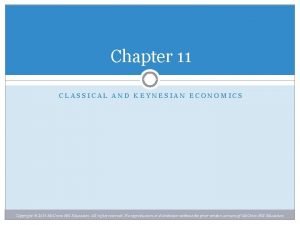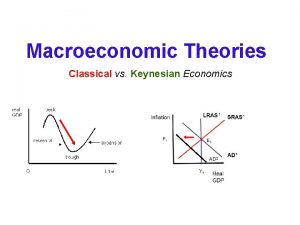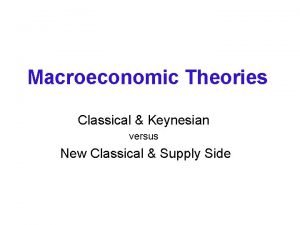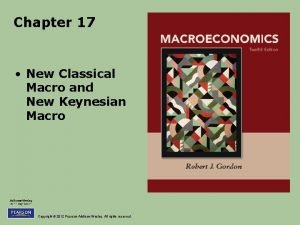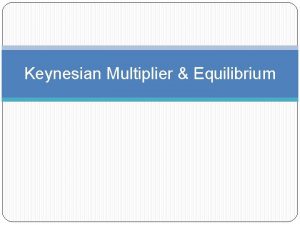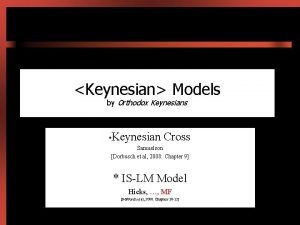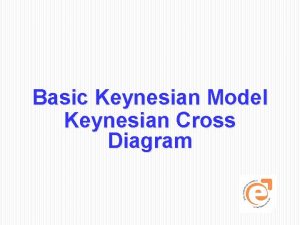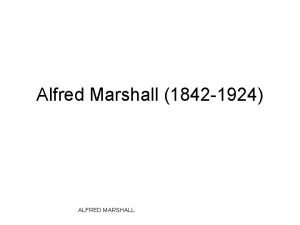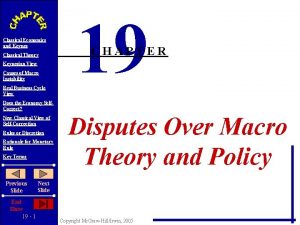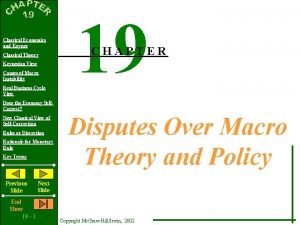The Keynesian Cross vs the Classical Cross Alfred









- Slides: 9

The Keynesian Cross vs the “Classical” Cross Alfred Marshall John Maynard Keynes A Telling Exercise in Comparative Frameworks Roger W. Garrison 2010

EXPENDITURES a = 2, 000 b = 0. 75 I = 1, 250 I a 45 O Y=E E=C+I Combining Expenditures Spending In The a wholly primary on private “Y=E” consumption playing on of the with economy, economy’s field “E=C+I” for goods the and The intersection “E=C+I” with output is only taking Keynesian a stable other into become component function account macroeconomics 0 line the allowing of income C’sincome. ofrelationship spending paid has The “Y=E” (the 45 income to linear is the investment workers Ymeasured relationship allows and us spending tovertically of toother allows INCOME calculate (“I”), factors for some (Y) this of as C = a + b. Y with to bedimensions as which well 1 production. consumption is economy’s and simply EXPENDITURES added equilibrium “Y (“a”) = vertically E”even constitutes income. (E). when to all horizontally) identifies the circularb possible income consumption iscircular-flow (temporarily) spending zero. 1 flow equilibrium point equilibria. for(“C”) thisto get 1 total Y = Espending and E = C(“E”). +I particular economy. An upward slope (“b”) that is less So, = C means + I, where C when = a + b. Y than. Yone that people Combining: Y = a + b. Y + Ispend earn more income, they Yeq = 13, 000 more but that theyasave more, Suppose = 2, 000; b =too. 0. 75; INCOME (Y) and I = 1, 250. We can now write: C = 2, 000 + 0. 75 Y And Y = 2, 000 + 0. 75 Y + I, 250 If dollar magnitudes are in billions of dollars, then equilibrium income is Yeq = $13, 000 billion. Or: Y – 0. 75 Y = 2, 000 + I, 250 Simplifying: 0. 25 Y = 3, 250 Finally: Y = 13, 000

EXPENDITURES a = 2, 000 b = 0. 75 I = 1, 250 I a 45 O Y=E E=C+I For low levels of income, graph The income-expenditure consumption spending exceeds tracks consumption spending (C) income; in this lowasrange totalsaving spending (C+I) these C = a + b. Y and (shown in red) is negative. magnitudes relate to income. Indirectly, this graph keeps track of For higher levels of income, saving, too. consumption spending is less than income; saving in this range Saving (S), which simply means (shown in green) is positive. not spending some part of income can be written: S = Y – C. Where red and green meet, saving INCOME (Y) is neither negative positive. Graphically, S is thenor vertical People neither. Csaving distanceare between and Y. nor dissaving. Rather, S = 0 or, equivalently, C = Y.

EXPENDITURES Y=E E=C+I The We’ve seen function that the is equality derived First, saving we track saving (“S”) asofit income from directly and the definition means of depends on expenditures income. that the(S economy = Y – C)isand in a the circular. C = a + b. Y saving The “a” in the upper panel, which flow equilibrium. consumption function (C = a + b. Y): is consumption spending with no We can now income, becomes show“-a” thatinthe theequality lower S=Y–C between saving andofinvestment panel, which indicates Now, for what level Y“dissaving. ” is S = 0? is C =alternative a + b. Y an condition for a The red-green boundary in the S = – a + (1 – equilibrium. b)Y circular-flow Combining: S = Y – (a + b. Y) upper panel marks the point in the S = – 2, 000 + (1 – 0. 75)Y Distributing: S=Y– a – b. Yis zero. lower panel where saving a = 2, 000 b = 0. 75 I = 1, 250 I a 45 O SAVIING (S) INVESTMENT (I) INCOME (Y) the saving function. YS=0 = 8, 000 [YS=0); S = 0] –a S = – 2, 000 + 0. 25 Y Rearranging: S = the –a+ Y – b. Y We now connect (negative) S = – of 2, 000 + 0. 25 Y =0 level saving when and the Factoring: S=– a + (1 Y=0 – b)Y level of income when S=0 to depict – 2, 000 = – 0. 25 Y 1 -b [Y = 0; 1 S = – a] INCOME (Y) S = – a + (1 – b)YY = 20/0. 25 = 8, 000

EXPENDITURES a = 2, 000 b = 0. 75 I = 1, 200 Y=E E=C+I The income ranges of dissaving (red) and saving (green) are more C = a + b. Y obvious with S graphed by itself. Now, we show that investment (I) does not depend on income. I a 45 O SAVIING (S) INVESTMENT (I) INCOME (Y) S I I –a INCOME (Y) We note that the equality of saving and investment occurs at the same level of income at which income equals expenditures. Notice also that all the information contained or implied in the Y=E graph is also contained or implied in the S=I graph.

THE KEYNESIAN CROSS THE “CLASSICAL” CROSS The Keynesian Cross, featuring the intersection of Y and E or of S and I, is fundamental to Keynesian theory. The Keynesian Cross stands in contrast to the “Classical” Cross, whose relevance presuppose that markets work. S RATE OF INTEREST SAVIING (S) INVESTMENT (I) Its relevance presupposes that labor markets and output markets are dysfunctional and that the interest rate is out of play. S I D I INCOME (Y) I SAVIING (S) INVESTMENT (D)

SAVIING (S) INVESTMENT (I) And that’s good: if saving were to shift upward, income spirals downward until the equilibrium level of saving, once again, equals the unchanged level of investment. This is Keynes’s Paradox of Thrift. S I INCOME (Y) Marshall argued that the supply and demand for loanable funds are fully functional. If saving shifts rightward, the interest rate falls, stimulating an increased level of investment. RATE OF INTEREST Keynes argued that the saving curve doesn’t shift. The parameters “a” and “b” don’t change. S D SAVIING (S) INVESTMENT (D)

We can identify significant similarities and differences between Keynesian theory and classical theory by responding to a few revealing questions. Al, you’re YES…. Income No. The Only government –with adjusts. by just “equilibrium” accident an. The should or understood economy design fuddy-duddy! is this stimulus spirals asequality apackages balance up or between down consistent to supplement untilincome saving with spending full and is expenditures. brought employment. and driveinthe lineeconomy with to investment. full employment. S I INCOME (Y) YESinterest YES…. The Yes. About –with The what? ? wage “equilibrium” rate There rate adjusts, is no understood moving too, need infor the up stimulus face orasdown aofbalance packages. shortages in between response or The surpluses government loanable to shortages of labor. should fundsorget supplied surpluses Where out of the did and market’s of you loanable demanded. learnway your funds. and microeconomics, let it work. Laissez. Maynard? faire! RATE OF INTEREST SAVIING (S) INVESTMENT (I) Just Is Does What thehow “equilibrium” the equality should is market this the ofadjustment saving itself government entail bring and an made about equality do in investment of a about market saving-investment saving it? economy? and consistent investment? equality? with maintaining full employment? S D SAVIING (S) INVESTMENT (D)

The Keynesian Cross vs the “Classical” Cross Alfred Marshall John Maynard Keynes A Telling Exercise in Comparative Analytical Frameworks Roger W. Garrison 2010
 Three ranges of the as curve
Three ranges of the as curve Economics keynesian vs classical
Economics keynesian vs classical Classical economics vs keynesian
Classical economics vs keynesian New classical and new keynesian macroeconomics
New classical and new keynesian macroeconomics Classical economics vs keynesian
Classical economics vs keynesian Classical economics vs keynesian
Classical economics vs keynesian Monetarist vs keynesian vs classical
Monetarist vs keynesian vs classical New classical and new keynesian macroeconomics
New classical and new keynesian macroeconomics Monetarist vs classical economics
Monetarist vs classical economics Keynesian vs classical vs monetarist
Keynesian vs classical vs monetarist
